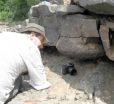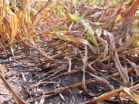New light shed on cause of lung injury in severe flu
New research published in the Journal of Leukocyte Biology suggests that natural killer T cells reduce the accumulation of monocytes and prevent lung injury in severe flu, controlling the outcome of infection
2012-03-01
(Press-News.org) While some scientists report engineering a super virulent strain of the H5N1 influenza virus, which could potentially wipe out a significant percentage of the human population, another group of researchers from the United Kingdom now reports a discovery that may one day help mitigate the deadly effects of all flu strains. This report, appearing in the March 2012 print issue of the Journal of Leukocyte Biology, describes findings that may help prevent deaths from severe flu outbreaks, especially from seemingly healthy young people. Specifically, the researchers found that immune cells called, "natural killer T cells," may reduce the overwhelming numbers of another type of immune cell, called "inflammatory monocytes," which when present in large numbers, lead to lung injury at the end stage of severe flu infection.
"We hope this study will ultimately benefit individuals—especially the young—who succumb to a severe form of flu infection," said Ling-Pei Ho, M.D., Ph.D., the researcher who led the work from the MRC Human Immunology Unit, Oxford University in Oxford, United Kingdom. "The study highlights a key immune process that occurs in severe flu infection, and provides a platform for a new approach and further research in this area."
To make their discovery, scientists infected three groups of mice with H1N1 flu virus. (Note: this is NOT the H5N1 flu virus that has been at the center of recent controversy.) The first group included normal mice; the second group was devoid of natural killer T cells, and the third was given a treatment that specifically activated natural killer T cells. Researchers observed the outcome of flu infection and found that the mice without natural killer T cells did worst, and those with activated killer T cells did best. Mice that lacked natural killer T cells had increased amounts of monocytes in the lungs, and severe lung injury similar to those seen in Spanish flu and lethal swine flu. Using highly-sensitive fluorescent antibody technology, this study was one of the first to document the sequential changes in innate immune response in the lungs during severe flu infection. These findings essentially provide a "road map" of the chronological changes in the lungs during severe flu infection.
"Despite affecting practically everyone, the flu may be one of the most underestimated viruses in terms of its devastating potential," said John Wherry, Ph.D., Deputy Editor of the Journal of Leukocyte Biology. "As the H5N1 research shows, it is quite possible for the virus to mutate or be bioengineered into a form that could wipe most of us out. What most people don't realize is that the severe illness from these flu strains is caused by both the virus and an overaggressive or inappropriate immune response. Research like this, however, offers hope that we'll be able to find more universal ways improve the effectiveness of immunity and combat the severe strains of the flu."
###
The Journal of Leukocyte Biology (http://www.jleukbio.org) publishes peer-reviewed manuscripts on original investigatins focusing on the cellular and molecular biology of leukocytes and on the origins, the developmental biology, biochemistry and functions of granulocytes, lymphocytes, mononuclear phagocytes and other cells involved in host defense and inflammation. The Journal of Leukocyte Biology is published by the Society for Leukocyte Biology.
Details: Wai Ling Kok, Laura Denney, Kambez Benam, Suzanne Cole, Colin Clelland, Andrew J. McMichael, and Ling-Pei Ho. Invariant NKT cells reduce accumulation of inflammatory monocytes in the lungs and decrease immune-pathology during severe influenza A virus infection. J. Leuk. Biol. March 2012; 91:357-368; doi:10.1189/jlb.0411184; http://www.jleukbio.org/content/91/3/357.abstract
END
ELSE PRESS RELEASES FROM THIS DATE:
2012-03-01
An international team, including a Cardiff University researcher, who previously found evidence of the Earth's earliest tree, has gone one step further.
The research team has now unearthed and investigated an entire fossil forest dating back 385 million years.
The Gilboa fossil forest, in the Catskill Mountains in upstate New York, is generally referred to as 'the oldest fossil forest'. Yet by scientific standards it has remained mythical.
Fossils of hundreds of large tree stumps (the 'Gilboa tree') preserved in the rocks were discovered in the 1920's during excavation ...
2012-03-01
As the old adage goes, nothing in this world is certain but death and taxes. Unfortunately, in recent times this saying is more pertinent than ever, as there is now a direct and immediate link between taxes and the end of life.
Known derisively by some as the death tax, the federal estate tax (along with its cousins, the generation-skipping tax and the gift tax) can take a substantial bite out of intergenerational wealth. However, a tax relief package in effect until the end of 2012 can help you and your estate planning attorney develop an effective strategy to limit ...
2012-03-01
CHAMPAIGN, Ill. — High corn prices are leading many growers to plant corn every year and to overuse pesticides and other bug-killing technology to maximize yields, researchers report. In many instances, pesticides are applied without scouting fields to see if they are needed, violating a bedrock principle of integrated pest management. The result is a biological diversity desert in many corn and soybean fields in the agricultural Midwest, and signs that the surviving insects are becoming resistant to several key bug-fighting tools now available to farmers.
University ...
2012-03-01
DURHAM, N.C. -- Voting behavior cannot be predicted by one or two genes as previous researchers have claimed, according to Evan Charney, a Duke University professor of public policy and political science.
In "Candidate Genes and Political Behavior," a paper published in the February 2012 American Political Science Review, Charney and co-author William English of Harvard University call into question the validity of all studies that claim that a common gene variant can predict complex behaviors such as voting.
They use as an example a 2008 study by James H. Fowler and ...
2012-03-01
Scientists have combined two new "designer" forms of aspirin into a hybrid substance that appears more effective than either of its forebears in controlling the growth of several forms of cancer in laboratory tests. Their report on the new NOSH-aspirin, so named because it releases nitric oxide (NO) and hydrogen sulfide (H2S), appears in the journal ACS Medicinal Chemistry Letters.
Khosrow Kashfi, Ravinder Kodela and Mitali Chattopadhyay point out that NO and H2S are signaling substances produced in the body that relax blood vessels, reduce inflammation and have a variety ...
2012-03-01
If you have been injured in a motor vehicle accident in Utah, you probably have many things on your mind. You could be worried about:
- Paying your medical bills
- Covering your wages if you are forced to be out of work
- Getting your car repaired
- Having to pay for a rental car
Utah laws mandating specific types of car insurance coverage should allow you to rest easier. Utah is what is known as a "no-fault" automobile insurance state. This means that essentially the law is designed to keep insurance premiums lower by discouraging lawsuits between drivers. ...
2012-03-01
New Orleans, LA – Research led by Nicolas Bazan, MD, PhD, Boyd Professor and Director of the Neuroscience Center of Excellence at LSU Health Sciences Center New Orleans, has found that a synthetic molecule protected the brain in a model of experimental stroke. Dr. Bazan was issued a patent on the molecule called LAU-0901, a low molecular weight drug that crosses the blood-brain barrier. The findings are published in the March 2012 issue of Translational Stroke Research.
During an ischemic stroke, the most common kind, the body releases signals that cause neuroinflammation ...
2012-03-01
Diversity has become a goal for all sorts of institutions—but what it means may depend on who you ask. A new study published in Psychological Science, a journal of the Association for Psychological Science, finds that people's ideologies help determine what they count as "diverse."
Miguel Unzueta, the study's lead author, notes that "diversity" historically meant inclusiveness toward historically disadvantaged groups. Now, however, the term is commonly used to refer to people who are different in any way (even personality traits and food preferences)—and that, Dr. Unzueta ...
2012-03-01
GAINESVILLE, Fla. --- The discovery of two new extinct camel species by University of Florida scientists sheds new light on the history of the tropics, a region containing more than half the world's biodiversity and some of its most important ecosystems.
Appearing online this week in the Journal of Vertebrate Paleontology, the study is the first published description of a fossil mammal discovered as part of an international project in Panama. Funded with a grant from the National Science Foundation, UF paleontologists and geologists are working with the Panama Canal Authority ...
2012-03-01
An inexpensive device used by millions of people with diabetes could be adapted into a home DNA detector that enables individuals to perform home tests for viruses and bacteria in human body fluids, in food and in other substances, scientists are reporting in a new study. The report on this adaptation of the ubiquitous personal glucose monitor, typically used to test blood sugar levels, appears in ACS' journal Analytical Chemistry.
Yi Lu and Yu Xiang point out that developing low-cost tests for the public to use for early diagnosis of diseases, checking the safety of ...
LAST 30 PRESS RELEASES:
[Press-News.org] New light shed on cause of lung injury in severe flu
New research published in the Journal of Leukocyte Biology suggests that natural killer T cells reduce the accumulation of monocytes and prevent lung injury in severe flu, controlling the outcome of infection

